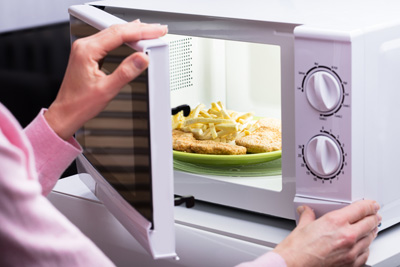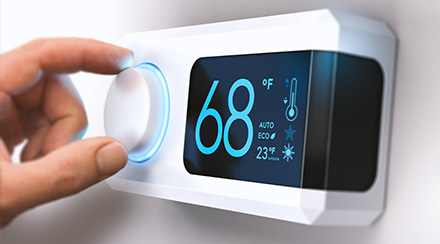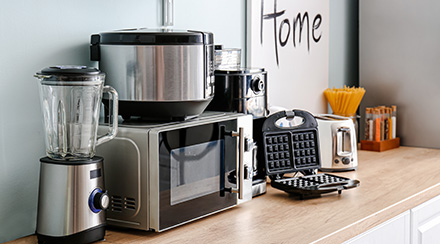How Many Watts Does a Microwave Use?

Your microwave may not be your go-to appliance for cooking gourmet meals, but in many households, it’s essential for grab-and-go grub, reheating leftovers and favorite snacks like popcorn. Not only is it fast, it’s energy efficient – most microwaves use a fraction of the energy an oven uses, and they often use less than other countertop kitchen appliances like air fryers and toaster ovens.
What is the Wattage of a Microwave?
Microwave wattage varies by model, but the average wattage of a microwave falls somewhere between 600 and 1,000 watts, according to EnergySage. There are higher wattage microwaves available, but these are more common in restaurants and commercial kitchens. To check the wattage of your microwave, you can refer to the owner’s manual or look for the information on a sticker or metal plate on the microwave itself.
The wattage tells you how much electricity the microwave will consume at full power, but most microwaves have multiple lower power settings that will use less.
How Much Does It Cost to Use a Microwave?
Microwave cooking is extremely inexpensive for two reasons: microwaves are relatively low-wattage compared to other cooking appliances, and they’re also faster, which means you use them less.
Let’s say you have a 1,000 watt microwave, which is on the high end of the typical range. You can run that appliance at full power for an entire hour for the cost of one kilowatt-hour (kWh) of electricity – usually around 13 cents. And we typically only use our microwaves for a minute or two at a time, which means you may be able to enjoy several weeks worth of microwaved meals for every dollar’s worth of electricity.
At 15 minutes of cooking per day with a 1,000 watt microwave, you’d consume about 7.5 kWh per month and 91.25 kWh per year. At 13 cents per kilowatt hour, that comes out to just 98 cents per month and $11.86 per year.
Compare that to an electric oven, which uses 2,000 to 5,000 watts of electricity on average, according to EnergySage. Assuming an oven on the high end of the typical wattage range at 5,000 watts, 15 minutes of daily cooking would cost you $4.87 per month and $59.31 per year. But electric ovens also cook food slower, and 15 minutes is barely enough time to cover preheating – so when it comes to energy efficiency, microwave cooking has a huge advantage.
Microwave Energy Efficiency Tips

The number one tip for microwave energy efficiency is simple: use your microwave whenever possible. Because microwaves are so much more efficient than most other cooking appliances, you’ll save the most energy by using them to replace cooking tasks you’d typically perform with an oven or stove.
Of course, the microwave isn’t the best tool for everything – it won’t get your fries as crispy as the air fryer, or give you the crunchy sear of a cast iron skillet – but if you use it to boil water, defrost frozen foods and reheat leftovers, you can do it for a fraction of the energy use required by other methods.
Here are a few of our other top microwaving tips:
- Clean your microwave regularly. Microwaves work by exciting the microscopic particles in your food, and the more particles there are, the longer they take to cook. Spilled food inside your microwave adds to the total volume of food being cooked, so you can get the most efficient cooking out of your appliance by keeping it clean. Be sure to periodically clean dust from any exterior vents, as well.
- Use your microwave during warm weather. Unlike your oven, air fryer and toaster oven, your microwave won’t add unwanted heat to your home during air conditioning season. You can also save energy during summertime by doing more grilling and outdoor cooking, and by saving your oven use for the evening hours, when temperatures are cooler.
- Pay attention to wattage when buying a new microwave. There is no ENERGY STAR certification for microwaves, so you’ll need to pay attention to the product details when choosing a new model. Lower-wattage microwaves are sufficient for most cooking tasks, but they may require additional cooking time, which can cut into their energy efficiency advantage.
Microwave cooking is not only easy on the cook, it’s easy on the wallet. It’s just one more thing to appreciate the next time you pop a bag of popcorn!
Be sure to check out some of the biggest energy users in your home, such as the washer and dryer, dishwasher, and refrigerator.
Looking for Something Specific?
Select a category to find resources for topics that interest you.
Select Category

Related Articles:

Tips for Improving Your AC and Furnace Efficiency
We share maintenance tips for your heater and AC, and home improvement tips to help you use those systems less.
Read Article
Tips for Saving on Energy in Your Home
If you’re looking to learn more about energy efficiency for home systems and appliances, we’re sharing our favorite energy-saving tips.
Read Article
What Uses the Most Electricity In a Home?
We break down what uses the most energy in your home to give you an understanding of where your energy usage goes and where energy-saving tactics can make the most impact.
Read ArticleMost Popular Articles

Energy Plans to Fit Your Lifestyle
NRG offers electricity and natural gas plans with perks like cash back, travel rewards and more, so you can find a plan that fits your home and family.
How Many Watts Does a Microwave Use?
Your microwave may not be your go-to appliance for cooking gourmet meals, but in many households, it’s essential for grab-and-go grub, reheating leftovers and favorite snacks like popcorn. Not only is it fast, it’s energy efficient – most microwaves use a fraction of the energy an oven uses, and they often use less than other countertop kitchen appliances like air fryers and toaster ovens.
What is the Wattage of a Microwave?
Microwave wattage varies by model, but the average wattage of a microwave falls somewhere between 600 and 1,000 watts, according to EnergySage. There are higher wattage microwaves available, but these are more common in restaurants and commercial kitchens. To check the wattage of your microwave, you can refer to the owner’s manual or look for the information on a sticker or metal plate on the microwave itself.
The wattage tells you how much electricity the microwave will consume at full power, but most microwaves have multiple lower power settings that will use less.
How Much Does It Cost to Use a Microwave?
Microwave cooking is extremely inexpensive for two reasons: microwaves are relatively low-wattage compared to other cooking appliances, and they’re also faster, which means you use them less.
Let’s say you have a 1,000 watt microwave, which is on the high end of the typical range. You can run that appliance at full power for an entire hour for the cost of one kilowatt-hour (kWh) of electricity – usually around 13 cents. And we typically only use our microwaves for a minute or two at a time, which means you may be able to enjoy several weeks worth of microwaved meals for every dollar’s worth of electricity.
At 15 minutes of cooking per day with a 1,000 watt microwave, you’d consume about 7.5 kWh per month and 91.25 kWh per year. At 13 cents per kilowatt hour, that comes out to just 98 cents per month and $11.86 per year.
Compare that to an electric oven, which uses 2,000 to 5,000 watts of electricity on average, according to EnergySage. Assuming an oven on the high end of the typical wattage range at 5,000 watts, 15 minutes of daily cooking would cost you $4.87 per month and $59.31 per year. But electric ovens also cook food slower, and 15 minutes is barely enough time to cover preheating – so when it comes to energy efficiency, microwave cooking has a huge advantage.
Microwave Energy Efficiency Tips
The number one tip for microwave energy efficiency is simple: use your microwave whenever possible. Because microwaves are so much more efficient than most other cooking appliances, you’ll save the most energy by using them to replace cooking tasks you’d typically perform with an oven or stove.
Of course, the microwave isn’t the best tool for everything – it won’t get your fries as crispy as the air fryer, or give you the crunchy sear of a cast iron skillet – but if you use it to boil water, defrost frozen foods and reheat leftovers, you can do it for a fraction of the energy use required by other methods.
Here are a few of our other top microwaving tips:
- Clean your microwave regularly. Microwaves work by exciting the microscopic particles in your food, and the more particles there are, the longer they take to cook. Spilled food inside your microwave adds to the total volume of food being cooked, so you can get the most efficient cooking out of your appliance by keeping it clean. Be sure to periodically clean dust from any exterior vents, as well.
- Use your microwave during warm weather. Unlike your oven, air fryer and toaster oven, your microwave won’t add unwanted heat to your home during air conditioning season. You can also save energy during summertime by doing more grilling and outdoor cooking, and by saving your oven use for the evening hours, when temperatures are cooler.
- Pay attention to wattage when buying a new microwave. There is no ENERGY STAR certification for microwaves, so you’ll need to pay attention to the product details when choosing a new model. Lower-wattage microwaves are sufficient for most cooking tasks, but they may require additional cooking time, which can cut into their energy efficiency advantage.
Microwave cooking is not only easy on the cook, it’s easy on the wallet. It’s just one more thing to appreciate the next time you pop a bag of popcorn!
Be sure to check out some of the biggest energy users in your home, such as the washer and dryer, dishwasher, and refrigerator.
Looking for Something Specific?
Select a category to find resources for topics that interest you.
Select Category

Related Articles:

Tips for Improving Your AC and Furnace Efficiency
We share maintenance tips for your heater and AC, and home improvement tips to help you use those systems less.
Read Article
Tips for Saving on Energy in Your Home
If you’re looking to learn more about energy efficiency for home systems and appliances, we’re sharing our favorite energy-saving tips.
Read Article
What Uses the Most Electricity In a Home?
We break down what uses the most energy in your home to give you an understanding of where your energy usage goes and where energy-saving tactics can make the most impact.
Read ArticleMost Popular Articles

Energy Plans to Fit Your Lifestyle
NRG offers electricity and natural gas plans with perks like cash back, travel rewards and more, so you can find a plan that fits your home and family.







